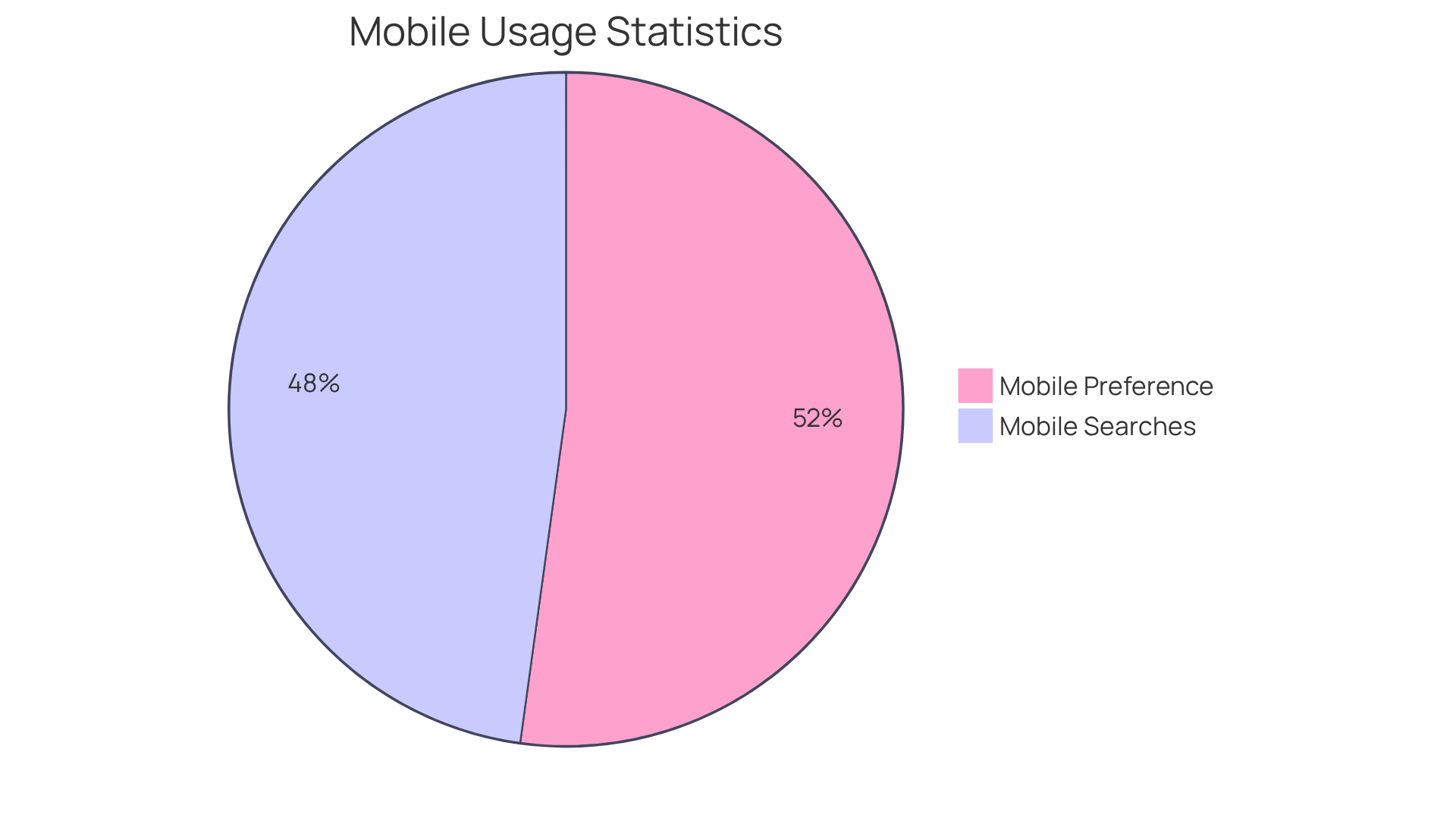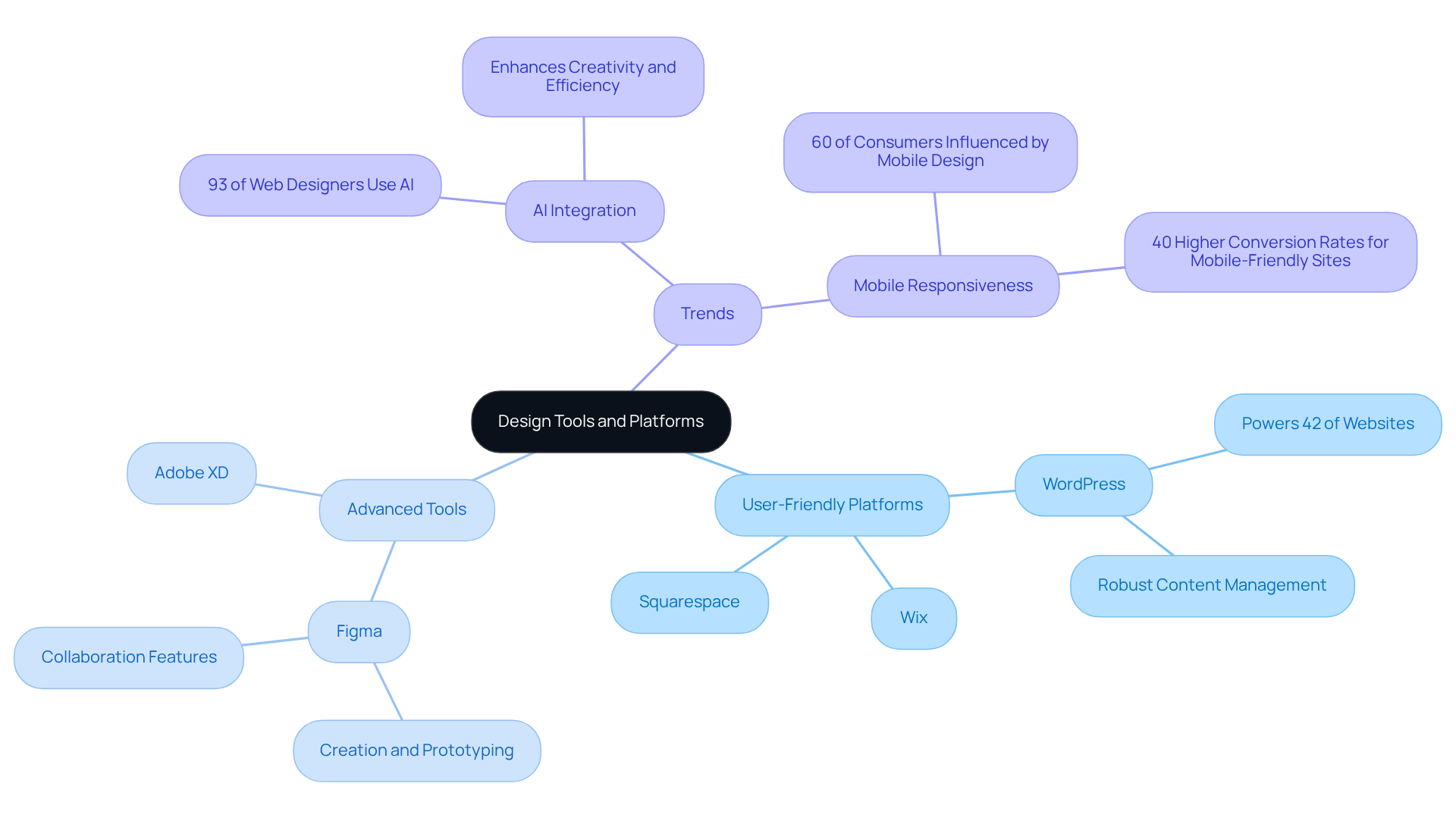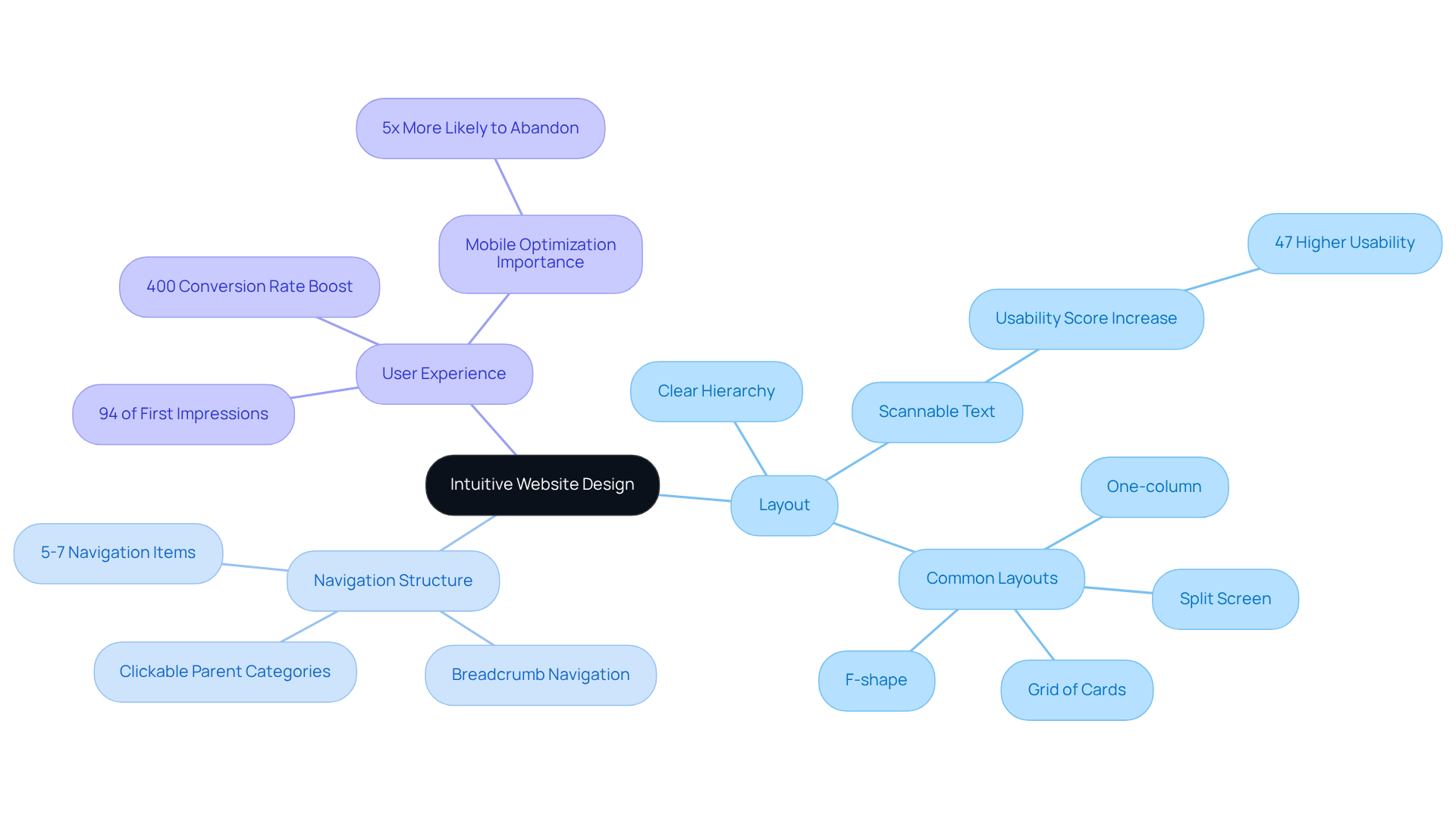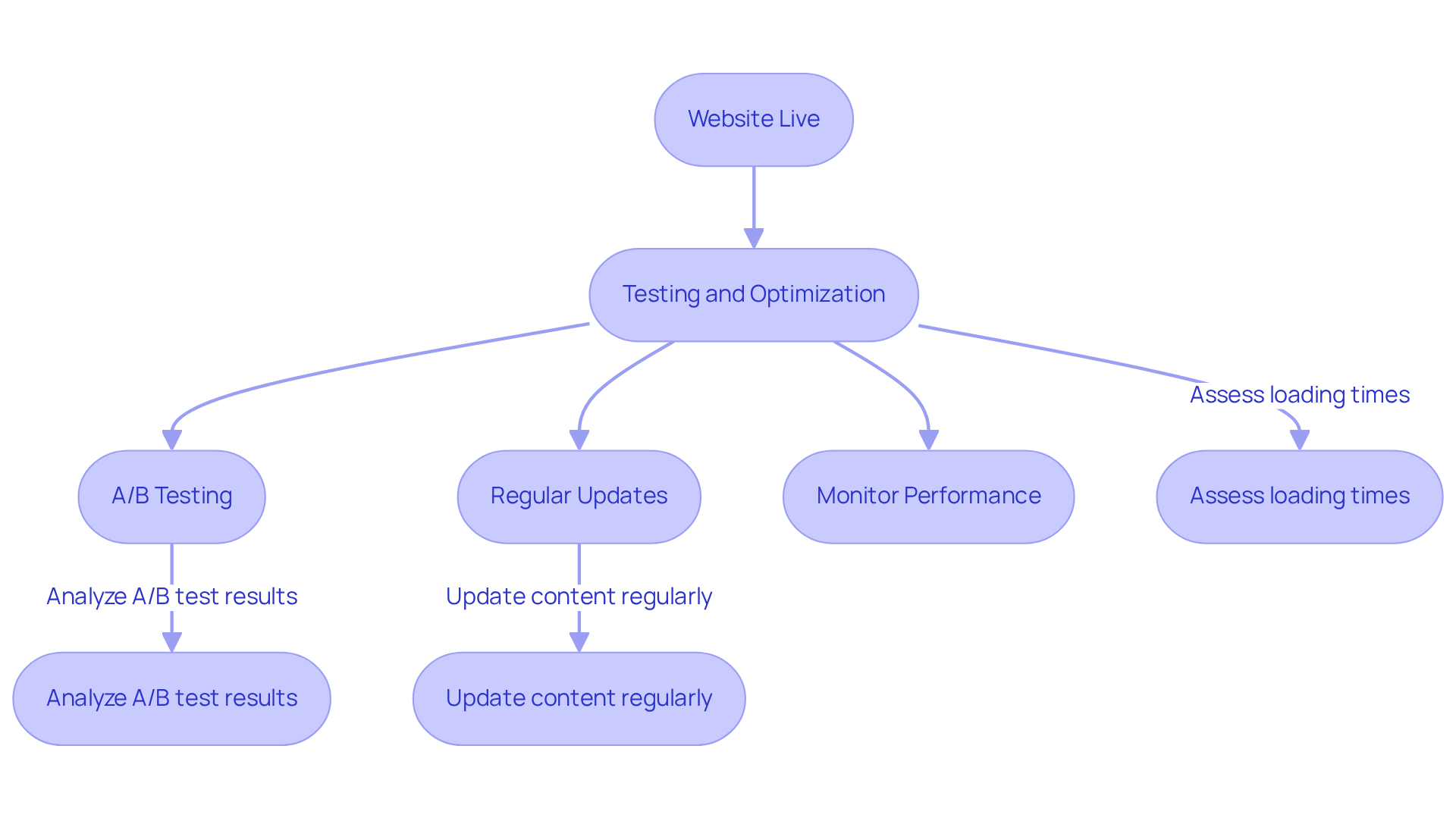Overview
When it comes to creating a successful online presence, many tech startup founders struggle with website design. The challenge often lies in defining the website's purpose and audience, which can feel overwhelming. This uncertainty can lead to frustration, as the right design tools and platforms may seem elusive. Without a clear layout and intuitive navigation structure, users can quickly lose interest, leading to missed opportunities for engagement and conversion.
However, there is hope. By embracing four essential practices, you can transform your website into a powerful tool for connection and growth:
- Define your website's purpose and audience, which will guide your design decisions.
- Choose the right design tools and platforms that resonate with your vision.
- Create an intuitive layout and navigation structure to enhance user experience, making it easier for visitors to engage with your content.
- Remember that ongoing testing and optimization are crucial; they ensure your website evolves with your audience's needs.
These practices not only improve user experience but also significantly boost conversion rates and credibility. Statistics show that a well-designed site can lead to a more successful online presence, ultimately nurturing the growth of your startup. By focusing on these elements, you can create a website that not only meets your professional goals but also fosters a sense of community and support among your users.
Introduction
Creating a successful website can feel overwhelming, especially when it seems like every business is vying for attention online. It’s not just about aesthetics; it’s about crafting a digital presence that truly reflects your brand. With technology evolving at lightning speed and user expectations constantly changing, it’s crucial to grasp the essential practices of effective website design.
This article explores four key practices that not only foster user engagement but also drive conversions, empowering businesses to flourish in a competitive online environment. As the digital landscape grows ever more crowded, you might wonder: how can your website stand out and genuinely cater to the diverse needs of your audience?
Together, let’s navigate this journey and discover the strategies that can help you connect meaningfully with your users.
Define Your Website's Purpose and Audience
Creating an effective website designing strategy can feel overwhelming, especially when you’re trying to define its purpose. Have you ever found yourself wondering about the primary goal? Is it to sell products, provide information, or generate leads? Once you establish that purpose, the next step is to identify your target audience. Conducting thorough market research can unveil valuable insights into demographics, preferences, and pain points that resonate with your potential visitors. For instance, tools like Google Analytics can help you examine user behavior, allowing you to craft personalized content and a layout that truly connects with your audience.
Imagine a technology startup that aims to engage a younger demographic seeking creative solutions. This startup may benefit from a contemporary, streamlined appearance that emphasizes usability and engagement. It’s important to note that statistics show:
- 84% of visitors prefer mobile platforms
- 77% of searches come from mobile devices
This highlights the necessity for a responsive layout that caters to this demographic. Furthermore, understanding your audience’s needs can significantly enhance user experience. In fact, 48% of internet users consider website designing a crucial aspect in establishing a business’s credibility. By prioritizing these elements in website designing, you can develop a platform that not only attracts visitors but also nurtures them into loyal customers. Remember, you’re not alone in this journey; by focusing on these key aspects, you can that truly resonates with your audience and meets their needs.

Choose the Right Design Tools and Platforms
Choosing the right development tools and platforms can feel overwhelming for tech startups, and it’s a challenge that many face. The stakes are high, as the success of an online project hinges on factors like ease of use, scalability, and integration capabilities. Platforms such as WordPress, Wix, and Squarespace stand out for their user-friendly interfaces and customizable templates, making them perfect for startups eager for website designing to establish a strong online presence quickly. Did you know that WordPress powers over 42% of all websites? Its robust content management capabilities are crucial for keeping content fresh and engaging.
For those startups with more complex needs, tools like Figma and Adobe XD can be game-changers. These platforms not only support creation and prototyping but also foster collaboration among team members, allowing for swift revisions based on client feedback. A great example of this is the Majestic Wine Inquiry Form Revamp, where the company significantly improved their results by refining their layout based on valuable insights from users.
Moreover, the rising trend of integrating AI tools into website designing workflows—embraced by nearly 93% of web developers—highlights the importance of choosing platforms that support such innovations. This integration can streamline processes and elevate quality, ultimately leading to better user experiences and higher engagement rates. With mobile traffic dominating the landscape—78% of retail and ecommerce website traffic comes from mobile devices—it’s vital to ensure that your chosen platform supports . After all, mobile-friendly websites enjoy 40% higher conversion rates. Prioritizing responsive design is crucial for enhancing user engagement and retention.

Design an Intuitive Layout and Navigation Structure
Creating an in website designing can feel overwhelming, especially for tech startup founders who want to make a strong first impression. A clean and organized approach to website designing is essential, as it naturally guides individuals through the content. However, when faced with a cluttered interface, it’s easy to feel lost. A clear hierarchy with headings, subheadings, and bullet points can significantly improve scannability, making it simpler for users to absorb information.
Imagine how frustrating it can be for visitors when they can’t find what they’re looking for. By restricting the primary navigation menu to 5-7 items, you can avoid overwhelming them. Additionally, introducing breadcrumb navigation can clarify their position within the site, helping them feel more secure and informed.
For example, an eCommerce website that sorts items by type allows visitors to effortlessly transition from the homepage to specific product categories, reducing anxiety and enhancing their experience. This organized approach not only improves usability but also aligns with findings that show:
- 94% of first impressions are related to website designing
- 75% of individuals assess a website's credibility based on its design
It’s important to recognize that effective website designing can create a well-crafted interface that boosts conversion rates by as much as 400%, highlighting the financial benefits of investing in effective navigation systems. Yet, it’s essential to note that 91% of sites fail to highlight the individual’s current scope in the main navigation, leading to confusion and frustration.
By addressing these common challenges, you can significantly improve your platform's usability and credibility, nurturing a more positive experience for your users.

Test, Optimize, and Maintain Your Website
Once your website is live, it’s essential to establish a routine for testing and optimization in website designing to enhance performance and visitor engagement. Many founders face the challenge of ensuring their site runs smoothly, and it can be disheartening to see potential customers leave due to slow loading times. Tools like Google PageSpeed Insights can be invaluable in assessing loading times and identifying areas for enhancement; after all, even a can decrease transactions by up to 7%.
Consider the impact of A/B testing on your important pages. It’s a powerful way to determine which layouts or content resonate most effectively with your audience. For instance, HubSpot’s transition from a green to a red call-to-action button led to a remarkable 21% increase in engagement rates. This highlights how even small modifications can have substantial effects. Companies that embrace A/B testing often report significant increases in user engagement, with better UX design potentially boosting conversion rates by up to 400%.
Moreover, keeping your website up-to-date is crucial. Regularly refreshing content, fixing broken links, and ensuring compatibility with new browsers and devices can make a world of difference. However, it’s important to remember that only 1 out of 8 A/B tests in website designing tends to produce significant results, making proper execution vital. Be cautious of ending tests too early, as this can lead to misleading conclusions. The success stories of ongoing optimization efforts serve as a reminder of the value in nurturing your website’s performance through website designing and fostering a supportive online experience for your visitors.

Conclusion
Crafting an effective website can feel overwhelming, especially when clarity, usability, and audience engagement are at stake. Many founders struggle to define their website's purpose and truly understand their target audience, which can lead to missed opportunities in attracting visitors and converting them into loyal customers. This crucial first step not only influences the design choices that follow but also ensures that the website genuinely meets the needs of its intended users.
Key practices that can help include:
- Selecting the right design tools and platforms
- Creating an intuitive layout
- Establishing a navigation structure that feels natural
Each of these elements plays a vital role in enhancing the user experience and driving engagement. For example, choosing user-friendly platforms and responsive designs can significantly improve accessibility, while a well-organized navigation system fosters a seamless journey through your site. Moreover, committing to continuous maintenance and optimization is essential to keep your website performing at its best, ensuring it remains relevant and effective in meeting user expectations.
In conclusion, the importance of effective website design cannot be overstated. By implementing these essential practices, you can create compelling online experiences that resonate with users and foster trust. Embracing these strategies not only enhances the immediate impact of your website but also lays the groundwork for long-term success. As the digital landscape continues to evolve, staying attuned to best practices in website design will be crucial for any organization aiming to thrive online. Remember, you are not alone in this journey; together, we can navigate the complexities of website creation and ensure your vision comes to life.
Frequently Asked Questions
What is the first step in creating an effective website design strategy?
The first step is to define the website's purpose, such as whether it is to sell products, provide information, or generate leads.
How can I identify my target audience for my website?
You can identify your target audience by conducting thorough market research to gain insights into demographics, preferences, and pain points that resonate with potential visitors.
What tools can help analyze user behavior on my website?
Tools like Google Analytics can help you examine user behavior, which allows you to craft personalized content and an engaging layout.
Why is it important to have a responsive website layout?
A responsive layout is important because statistics show that 84% of visitors prefer mobile platforms and 77% of searches come from mobile devices, highlighting the need to cater to mobile users.
How does understanding my audience's needs impact user experience?
Understanding your audience's needs can significantly enhance user experience, as 48% of internet users consider website design a crucial aspect of a business's credibility.
What are the benefits of prioritizing website design elements?
Prioritizing website design elements can help attract visitors and nurture them into loyal customers by creating a platform that resonates with their needs.




